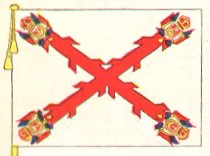Early Spanish expeditions
The Philippine Islands first came to the attention of Europeans with the Spanish expedition around the world led by Portuguese-born Spanish explorer Ferdinand Magellan in 1521. Magellan landed on the island called Homonhon, claiming the archipelago for Spain and naming them Islas de San Lazaro.[17] He established friendly relations with some of the local leaders espcially with Rajah Humabon and converted some of them to Roman Catholicism.[17] In the Philippines, they explored many islands including the island of Mactan. However, Magellan was killed in a battle he led against a datu named Lapu-Lapu.
Over the next several decades, other Spanish expeditions were dispatched to the islands. In 1543, Ruy López de Villalobos led an expedition to the islands and gave the name Las Islas Filipinas (after Philip II of Spain) to the islands of Samar and Leyte.[18] The name was extended to the entire archipelago in the twentieth century.
Spanish settlement
Permanent Spanish settlements were not established until 1565 when an expedition led by the Conquistador, Miguel López de Legazpi, arrived in Cebu from Mexico. Six years later, following the defeat of the local Muslim ruler, Rajah Sulaiman III, López de Legazpi established a capital at Manila, a location that offered the excellent harbor of Manila Bay, a large population, and proximity to the ample food supplies of the central Luzon rice lands. Manila became the center of Spanish government, including military, religious, and commercial activities in the islands.[19] Despite the opposition of the Portuguese, who desired to maintain their monopoly on East Indies trade,little armed resistance initially.[19] A significant problem the Spanish faced was the subjugation of the Muslims of western Mindanao, and the Sulu Archipelago. The Muslims, in response to attacks on them from the Spanish and their native allies, raided areas of Luzon and the Visayas that were under Spanish colonial control. The Spanish conducted intermittent military campaigns against the Muslims, but without conclusive results until after the middle of the 19th century.[20]

The Philippines would have had a similar battle standard, with the coat of arms of Manila in place of the one of Mexico City. Church and state were inseparably linked in Spanish policy, with the state assuming responsibility for religious establishments.[19] One of Spain's objectives in colonizing the Philippines was the conversion of the local population to Roman Catholicism. The work of conversion was facilitated by the absence of other organized religions, except for Islam, which predominated in the southwest. The pageantry of the church had a wide appeal, reinforced by the incorporation of indigenous social customs into religious observances.[19] The eventual outcome was a new Roman Catholic majority, from which the Muslims of western Mindanao and the upland tribal peoples of Luzon remained detached and alienated (such as the Ifugaos of the Cordillera region and the Mangyans of Mindoro).[19]
At the lower levels of administration, the Spanish built on traditional village organization by co-opting local leaders. This system of indirect rule helped create an indigenous upper class, called the principalia, who had local wealth, high status, and other privileges. This perpetuated an oligarchic system of local control. Among the most significant changes under Spanish rule was that the indigenous idea of communal use and ownership of land was replaced with the concept of private ownership and the conferring of titles on members of the principalia.[19]
The Philippines was not profitable as a colony during the early parts of Spanish rule, and a long war with the Dutch in the 17th century and intermittent conflict with the Muslims nearly bankrupted the colonial treasury.[19] Colonial income derived mainly from entrepôt trade: The Manila Galleons sailing from the Fort of Manila to the Fort of Acapulco on the west coast of Mexico brought shipments of silver bullion, and minted coin that were exchanged for return cargoes of Asian, and Pacific products. There was no direct trade with Spain

No comments:
Post a Comment